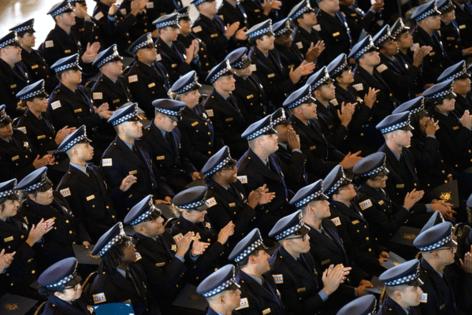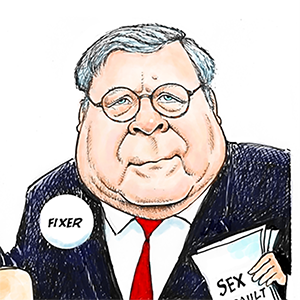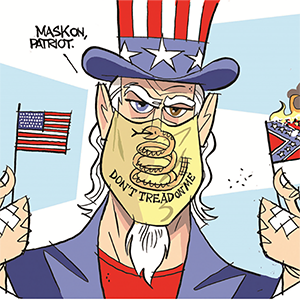Chicago Police Department striving for diversity on the force, but results depend on how new officers are counted
Published in News & Features
CHICAGO — Who wants to be a cop in Chicago?
Who gets to be a cop in Chicago?
Mayor Brandon Johnson told reporters last month that working toward long-standing goals to diversify the Chicago Police Department, the city has seen an increase in CPD applications from communities of color.
“We’re seeing positive results where we have a diverse workforce, our Police Department is becoming more and more diverse,” Johnson said.
“Interesting unknown fact people should know: There are more Latino individuals that are applying for these positions. There are more, still, Black candidates who are applying for these positions,” he added. “I believe that type of diversity is important. Almost 30% of the workforce are women in our Police Department. This is not the ’80s Police Department, right?”
But what the mayor did not mention is how those groups are counted and the rate at which different applicant categories are hired.
From the start of 2023 through the end of 2024, the city received more than 52,000 job applications from people seeking to join the ranks of the Chicago Police Department — an average of 500 applications per week for two years — according to city hiring data obtained by the Tribune.
In that time, CPD hired 2,301 people.
Of those brought onto the force, 979 identified as Hispanic/Latino, 945 applicants identified as white, 537 identified as Black, 104 identified as Asian, data show. But while the figures suggest progress on the diversity front, how much remains hazy with a closer look, beginning with the fact that those specified figures do not line up with the 2,301 total.
The city’s Human Resources Department categorizes “race” and “ethnicity” separately, similar to census data, and there is some overlap among the groups as candidates include their demographic information.
Of the 945 white officers hired since 2023, for example, nearly half said they are Hispanic/Latino, too, possibly lowering the approximate total of what appears on paper to be the largest segment. The result essentially means some candidates check multiple boxes and make gauging diversity results harder.
The hiring rate among each group also shows some inconsistencies.
A Tribune analysis of data from the city’s Department of Human Resources found that white candidates submitted 29% of applications, but accounted for 41% of officers hired. Among Black applicants that rate was nearly reversed, with those candidates submitting 41% of all applications but accounting for 23% of those hired in the last two full calendar years.
Representatives for the mayor’s office did not dispute the Tribune’s findings and did not comment on CPD’s recent hiring trends.
In a statement to the Tribune, a Police Department spokesperson said: “All applicants are held to the same standards, which include passing a background check, a physical fitness exam and a psychological exam. Candidates who do not meet the qualifications of the thorough pre-employment hiring process, regardless of their race, are removed from hiring eligibility.
“Additionally, throughout the past few years CPD has seen a number of applicants voluntarily remove themselves during the pre-employment hiring process. To address this, the recruitment and retention unit has streamlined the process to complete the hiring more quickly and efficiently. Recruiters are also responsible for conducting direct outreach to applicants as they move forward in each step of the pre-employment process with the goal of receiving a formal offer of employment.”
The department has used job fairs, social media and offered information at City Colleges in a bid to attract native Chicagoans — a third of whom identify as Latino.
CPD’s overall staffing has remained flat since 2023 as hiring has largely kept pace with officer retirements and other attrition.
However, the department does appear to have seen a sizable drop in the number of white officers. In January 2023, the department had 5,154 white officers, according to data from the city’s Office of Inspector General. Two years later, in January 2025, white officers totaled 4,720 — an 8% decline.
At the same time, the number of Hispanic/Latino police officers shot up from 3,692 in January 2023 to 4,043 in January 2025, largely offsetting the losses of white cops, and seemingly backing up the mayor’s contention.
The share of the department that identifies as Black or Asian remained, effectively flat, while nearly 400 new cops said they are multiracial.
Among the other findings, the data from the Department of Human Resources shows the next generation of Chicago cops is local. More than 90% of those hired already lived within city limits, especially in neighborhoods on the Southwest and Northwest sides that, for generations, have been home to scores of CPD officers and other municipal workers mandated to live in Chicago.
Ald. Ray Lopez, 15th, said he was encouraged to learn that the vast majority of new police hires are city residents. DHR data show more than 200 of those recently hired by CPD come from ZIP codes within the 15th Ward.
CPD officers, Lopez said, “have to have a neighborhood DNA” to better “understand the neighborhood you’re serving.”
“As police departments and districts are looking (like) and reflecting their communities better, we’re naturally going to see an uplift in community engagement, particularly when it’s hires from within those communities,” Lopez added. “I think being able to train local resident applicants who ultimately become CPD hires on constitutional policing will only benefit the department in the long-term.”
However, Lopez added that CPD’s applicant “rejection rate” was “very unsettling.”
“For the last three and half years we’ve been, basically, running a department short 1,800 bodies,” he added. “Even with attrition, then we should have 2,000 hires a year.”
The emerging shift in the racial makeup of the Police Department mirrors some of the takeaways from a community sentiment survey published earlier this year by the city’s consent decree independent monitoring team.
The monitoring team, led by former federal prosecutor Maggie Hickey of the law firm ArentFox Schiff, conducted the survey between March and April 2024. It found that, while still relatively high, satisfaction with CPD was declining among Chicago’s white residents but improving in other racial and ethnic groups.
“White respondents continued to express the most favorable opinions of the CPD followed by Latino respondents, Black respondents, and young Black men, who, on average, rated police lower than the Black Chicagoans in the general sample,” the survey found.
“The decline in positive ratings largely came from more negative perceptions among Latino and white Chicagoans,” the monitoring team said. “Black Chicagoans and young Black men viewed the CPD’s overall performance more favorably than they had in 2020, though their perceptions were still more negative than those of other groups.”
Chicago’s apparent gap in hiring Black officers is not a new problem.
In 2021, the city’s Office of Inspector General released a report on CPD’s hiring process. OIG noted that, at the time, Black candidates accounted for 37% of all applications but just 18% of all department hires.
“In examining the reasons for candidate attrition evident from available applicant data, OIG concluded that higher no-show rates and higher failure rates for Black candidates compared to other racial/ethnic groups drove the disproportionately high attrition rates in the standardized test and physical fitness test stages for Black candidates,” OIG previously found.
Experts have said there are clear advantages to diversity in the police ranks. Increased racial equity among the police department likely leads to fewer instances of police violence, some studies have found.
One published in 2021 in the journal Science analyzed data collected from nearly 3 million shifts worked by nearly 7,000 CPD officers between 2012 and 2015 — the years leading up to the release of the Laquan McDonald shooting video, the singular event that eventually sparked a U.S. Department of Justice investigation and, now, the city’s ongoing consent decree.
“Relative to white officers, Black and Hispanic officers make far fewer stops and arrests, and they use force less often, especially against Black civilians,” the study’s authors found. “These effects are largest in majority-Black areas of Chicago and stem from reduced focus on enforcing low-level offenses, with greatest impact on Black civilians.”
Any direct effect the number of officers has on street violence remains unclear, at least as it relates to head count.
Gun violence remains the biggest issue for the mayor and police leaders to address, and it remains an all-too-common fact of life for many of the most disadvantaged neighborhoods. Shooting totals and the number of homicides have steadily ticked down in recent years, in keeping with trends in other big cities across the country.
Police Department staffing data shows that, as of January 2025, the department had 11,722 officers — just nine fewer than it did two years earlier.
____
©2025 Chicago Tribune. Visit at chicagotribune.com. Distributed by Tribune Content Agency, LLC.







Comments